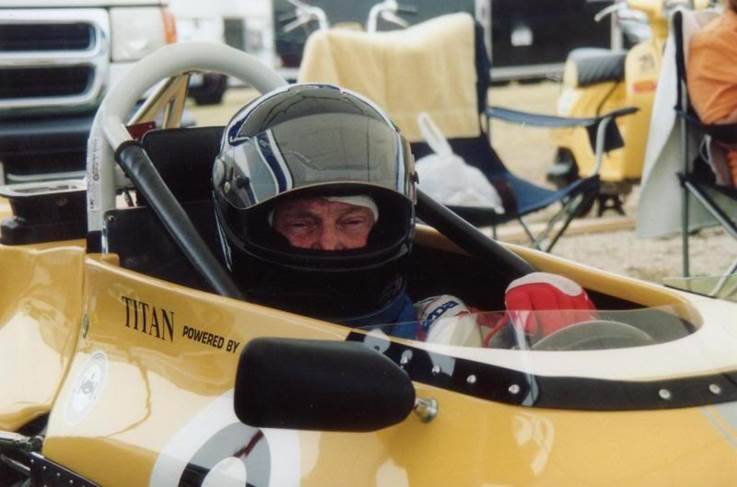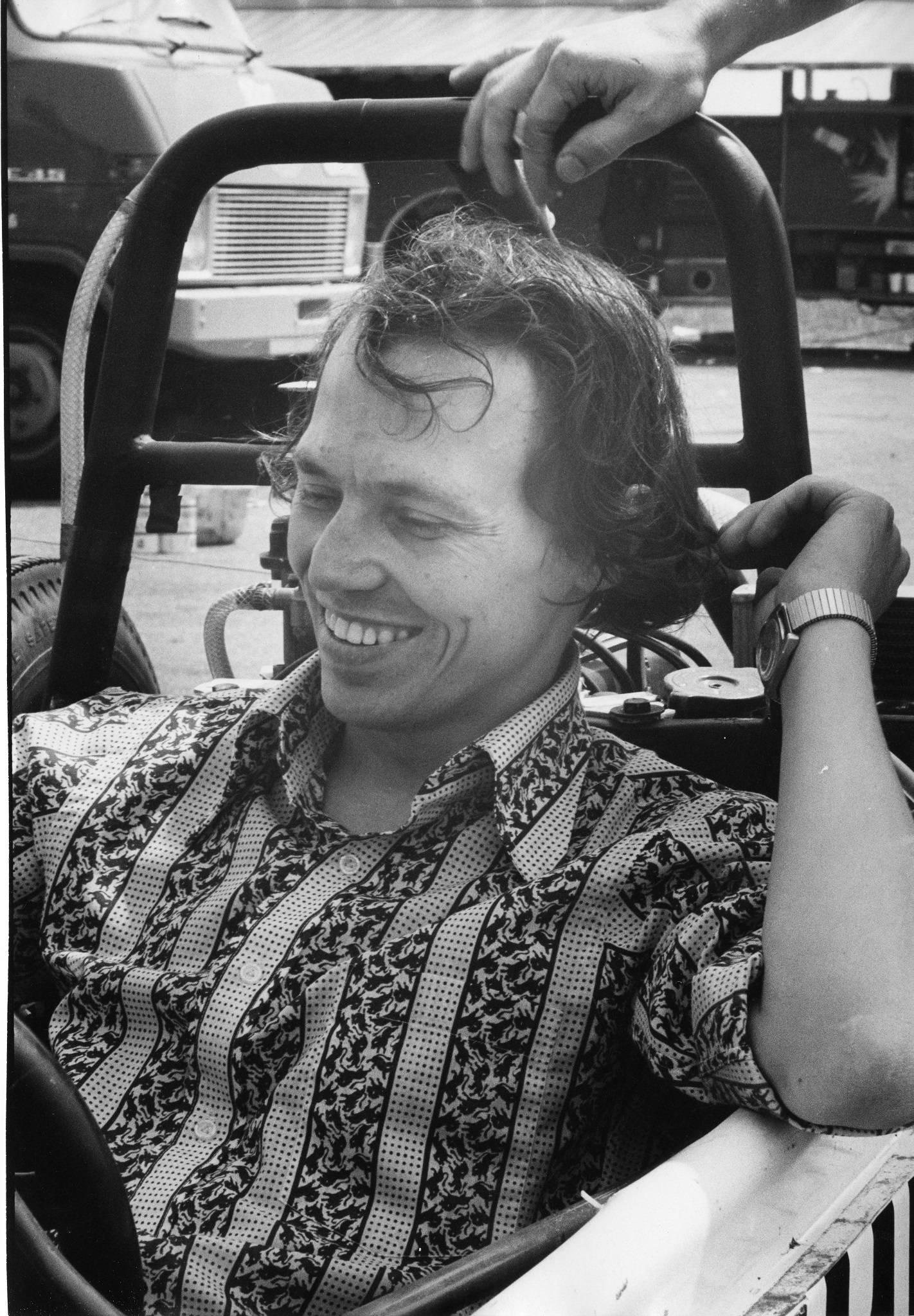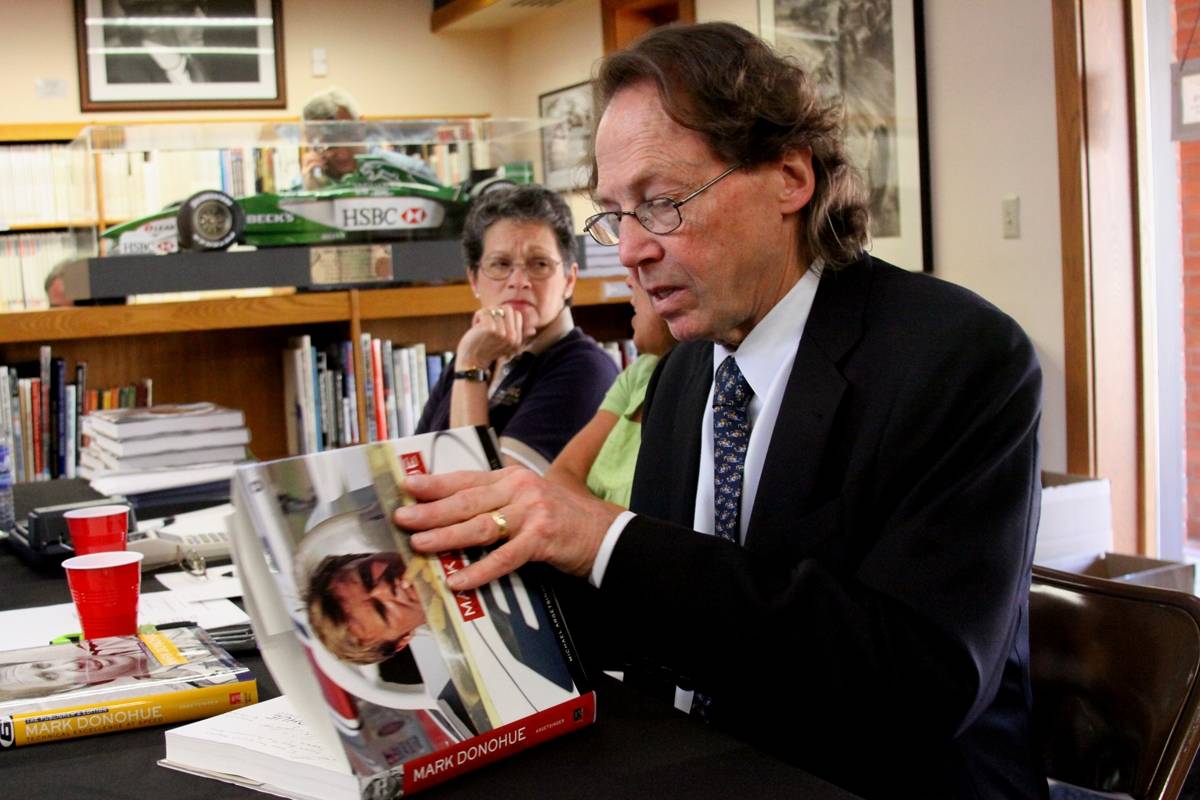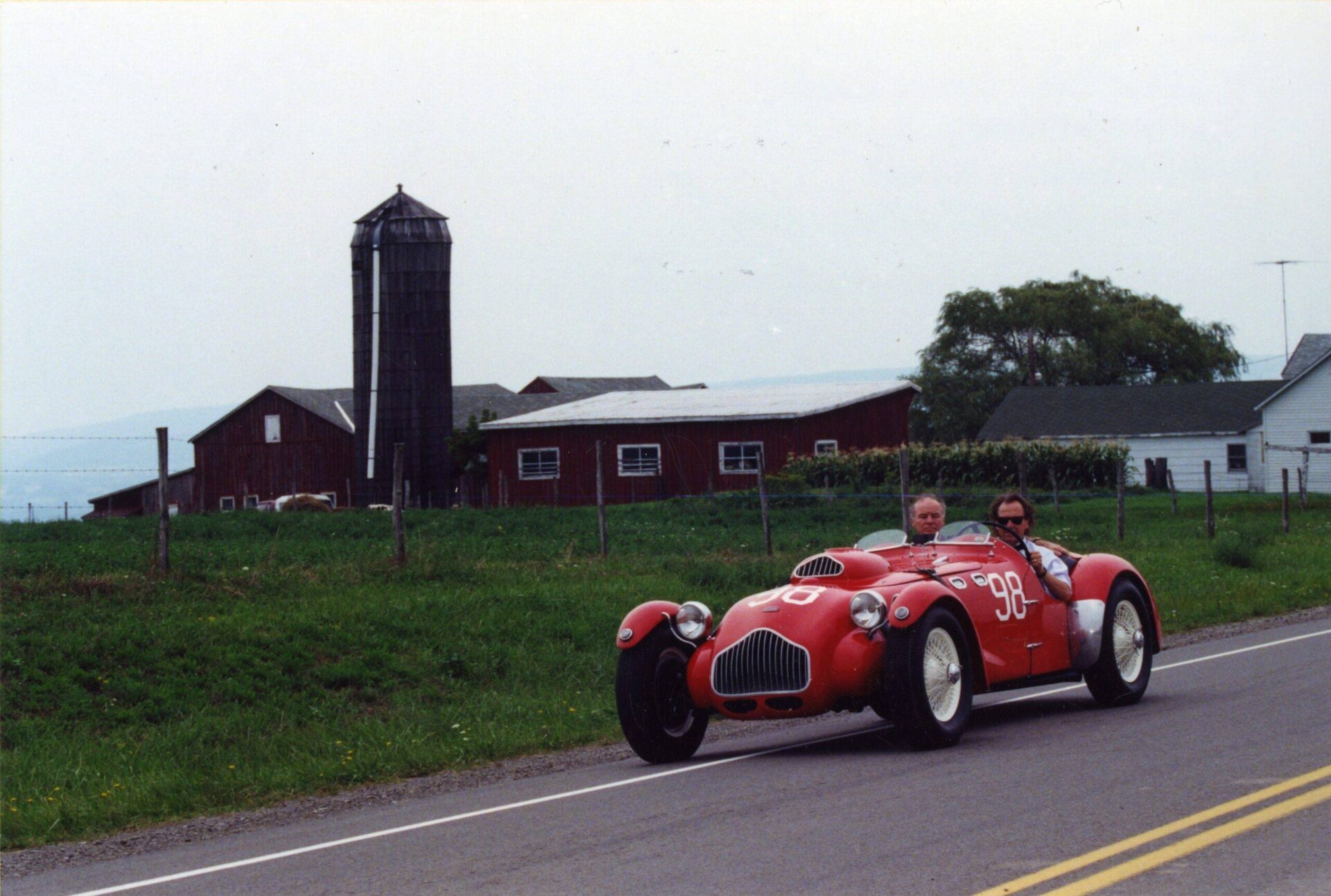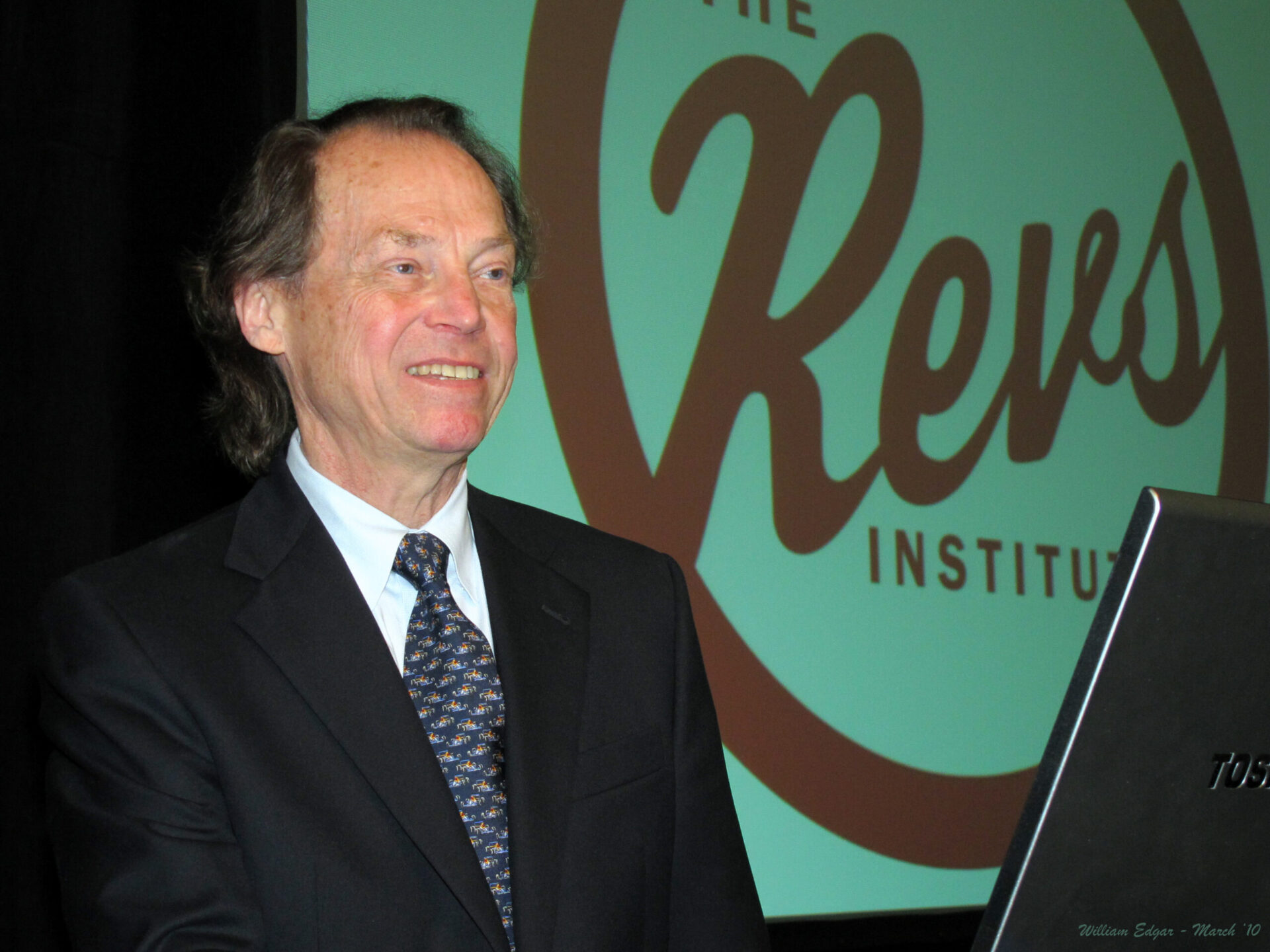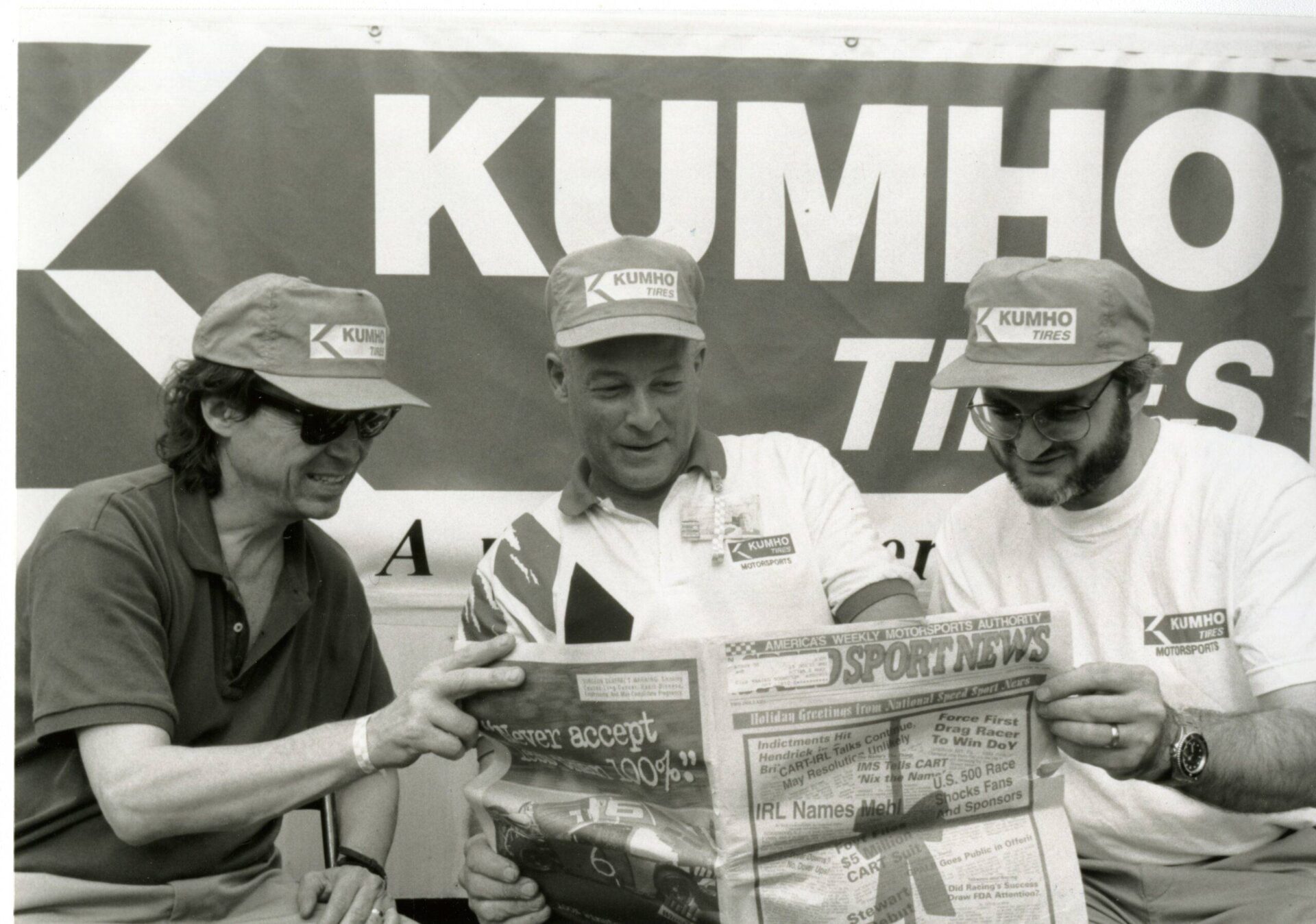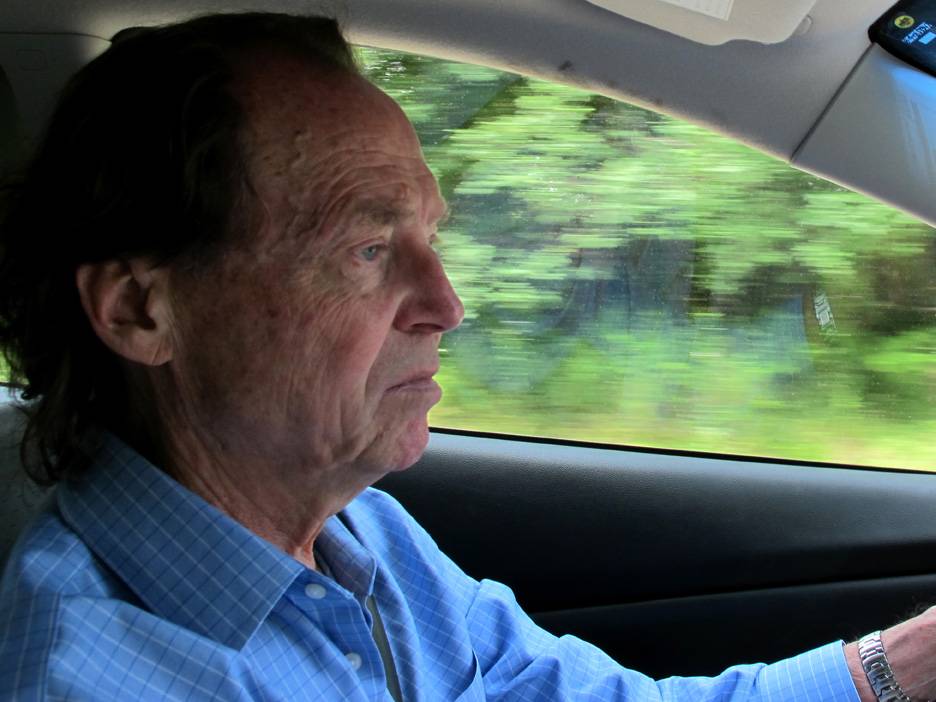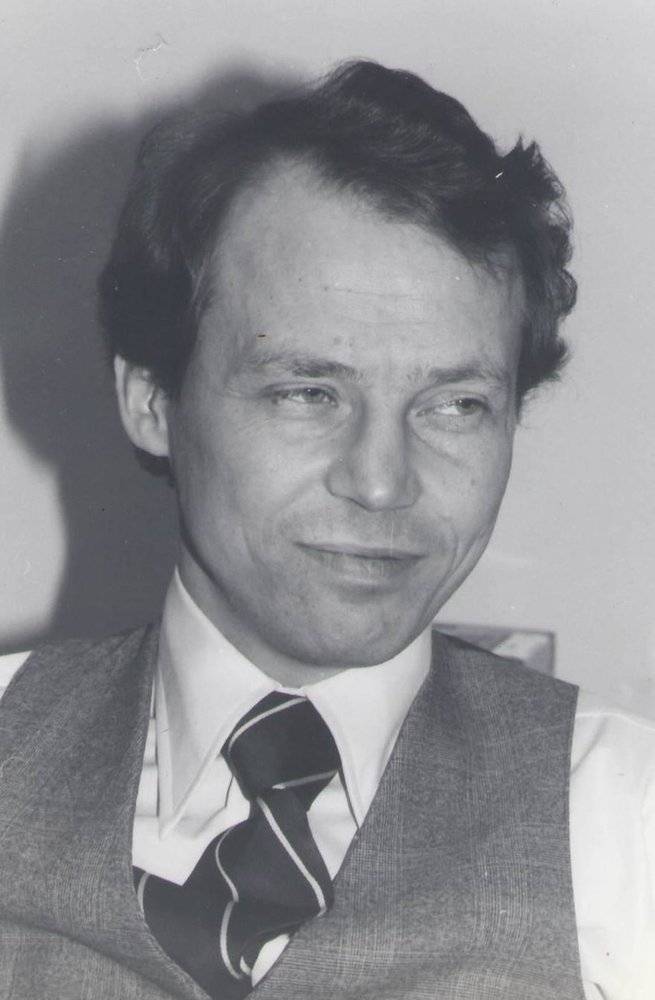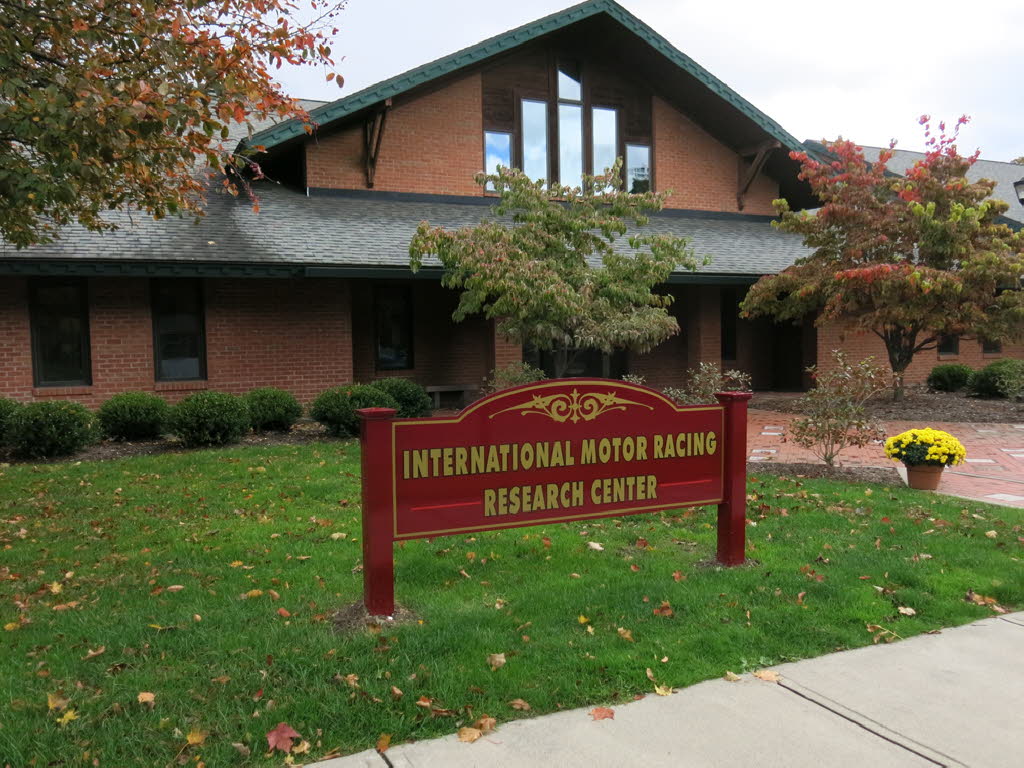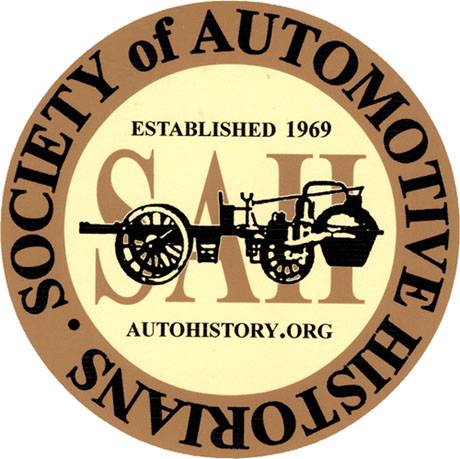Lauren Goodman received her MFA in screenwriting from the College of Motion Pictures Arts at Florida State University. While volunteering at the Revs Institute in Naples, Florida, she encountered one of two Maseratis entered by Lucy Schell in the 1940 Indy 500. Ms. Goodman’s research into Lucy’s time in France as a team owner and principal has been presented at Revs Institute. Her writing draws heavily on history and the lives of women whose achievements have been overlooked. Presently, she is developing Lucy’s story into a feature-length project. Ms. Goodman’s presentation will highlight Lucy’s role in motor racing history and her contributions to the sport.
Bio
Lauren Goodman received her MFA in screenwriting from the College of Motion Pictures Arts at Florida State University. While volunteering at the Revs Institute in Naples, Florida, she encountered one of two Maseratis entered by Lucy Schell in the 1940 Indy 500. Ms. Goodman’s research into Lucy’s time in France as a team owner and principal has been presented at Revs Institute. Her writing draws heavily on history and the lives of women whose achievements have been overlooked. Presently, she is developing Lucy’s story into a feature-length project. Ms. Goodman’s presentation will highlight Lucy’s role in motor racing history and her contributions to the sport.
Notes
Transcript
[00:00:00] Hello and welcome to the Gran Touring Motor Sports Podcast Break Fix, where we’re always fixing the break into something motor sports related. The following episode is brought to you in part by the International Motor Racing Research Center, as well as the Society of Automotive Historians, the Watkins Glen Area Chamber of Commerce and the Arts Inger family, Lucy O’Reilly, shell Innovator of French Motorsports by Lauren.
Good. Lauren Goodman has received her MFA in screenwriting from the College of Motion Pictures Arts at Florida State University. While volunteering at the Revs Institute in Naples, Florida, she encountered one of two Maseratis entered by Lucy Shell in the 1940 Indy 500 Ms. Goodman’s research into Lucy’s time in France as team owner and principal has been presented at the Revs.
Her writing draws heavily on history and the lives of women whose achievements have been overlooked. Presently, she’s developing Lucy’s story into a feature-length project. Ms. Goodman’s presentation will highlight Lucy’s role in motor racing [00:01:00] and her contributions to the sport. All right, folks. Next up is Lauren Goodman on Lucy Riley.
She. Well, good afternoon everyone. I’m so pleased to see so many faces here and online. Hello, out there in TV land. Hi mom. So a brief background about me in case we haven’t met before. My name’s Lauren Goodman and my background is not history, but in creative writing and filmmaking. My first love is story.
But during the pandemic, like a lot of us, I developed a new interest and specifically in cars that go really, really fast, and I started volunteering at the Revs Institute down in Naples, Florida, but it was while I was there, I encountered this beautiful. Eight cylinder Maserati that was entered in the 1940 Indie 500.
Now you can see on this car the French flag, the American flag. And then very curiously, this name [00:02:00] painted on the side, the l o r Shell special. And when I learned that the L there stands for Lucy, I had to know more. And it became kind of a passion for me and I, I’m looking forward to sharing her story with.
today’s presentation. I’m gonna give you a brief overview of her life and accomplishments. She was an established rally driver in her own right, but her real legacy was putting a little car company named Della Hay on the map in talking about Lucy’s work. We’re also gonna touch on her portrayal in the media at the time, and then later how she got ignored in some secondary sources about the history of Motorsport.
And finally, I’ll sum of just a few little thoughts about her. I. Lucy Marie Jean O’Reilly was born in Paris, October, 1896. Her father, Francis, was an American businessman whose own father had immigrated from Ireland, and the O’Reilly money came from building the railroads that were [00:03:00] the lifeblood of the gilded age.
Francis was already in his late forties when he decided to settle down in Paris with a young French widow, and when he died in 1937, he left Lucy her own personal. Now, Francis frequently traveled between Paris and Pennsylvania to attend business, but Lucy was 18 before she made her first trip to the us where in fact, in Redding, her arrival was news in the town paper.
And you can see here, she’s bringing news to the people of the town about her work as a nurse at the military hospital in Valgra, in Paris, really, when she was a teenager, she saw young men returning from the front suffering and sometimes dying from the wounds they received. And later in life, Lucy would again find herself locked in a battle with the Germans.
Another important character in this story is her husband. Whom she met around 1912, and they were married outside of Paris. In 1917, Celine Lawrence Shell, who was known [00:04:00] always as Lori, was born in Geneva to an American businessman and a family connection, gave them first employment at Butter Rosi. Some of you classic car lovers may know the name Butter Rosi.
In addition to war goods, they also constructed a few cars of their own, which were terrible, but he ended up also working for some coachwork around Paris, and he would provide a lot of coachwork for Lucy’s cars during her life. Here are the shells. They were a study in contrast. Lucy was gregarious, assertive.
Lori was soft spoken and diplomatic, but their egalitarian marriage made them a powerful team, both on and off the track. Lucy and Lori ran the Montecarlo rally together numerous times, sharing both navigational and driving responsibilities. And here they actually had a reporter come along with them one year, and he wrote a wonderful series of articles about his adventure with the shells as Renee d.
Who became very close to the couple later in life, wrote in his autobiography. There was no question, but that she was [00:05:00] absolutely an equal partner to Lori in their marriage. There was no subservient, no uns swerving, ob evasions, no pipe and slippers. Indeed, she was the driving force of the family. Lucy and Lori had two sons, Harry and Phillip.
Harry seems to have inherited the racing gene from both sides of the family and the Shell family resided both outside of Paris at Bruno and in. Lucy was already a mother and wife when she began to race. Seriously, her first race results show up in the French press in 1927, which would’ve made her about 31 years old.
Auto journalist Maurice. Felipe called her a decisive driver, and we can see she liked serious cars, serious French cars. That Talbot would’ve been branded as a DRock if sold in. At her very first hill climb in 1928, Lucy came first in her class. The reporter was surprised to see a woman that entered the race, but he said, if this little lady keeps at it, she’s gonna see some good results.
Good results. She didn’t indeed have. [00:06:00] Here’s just a selection of things I was able to pull from papers at the time. Now, Lucy’s specialty was the rally and the Monte Carlo was her white whale Lucy, with Lori’s code driver placed as high as P two. At the 1936 rally and lost out to a couple of Romanians in the strip down Ford by mere fractions of a point, it was her search for the right mix of performance, power, and reliability that led her to call on the factory offices at dhe.
At this point in time, Della Hay was a stuffy firm with a background in long-wearing sturdy truck engines. The general director of Della Hayes Factory, Charles’s wife. Known to everyone always as Mico Charl had grand plans to lead this company into a new era. Key to this plan were his engineer Jean, and a plan to break into the market for high-end high performance sports cars.
De Hay unveiled two new super lux models at the 1933 Barry Auto Salon, the 12 Chao [00:07:00] and the 18 Chao. These two super lux models were really just older models with updated suspension, but the stir in the press was enough that it caught Lucy’s attention. She appeared with Lori and Toe at the offices of Mr.
Charl to order a special, she wanted the bigger engine of the 18 shiau put into the smaller chassis of the 12. Mr. Charl said, no, no, no. It’s possible. The reason he said it wasn’t possible, it was because his engineer, John swa was trying to figure out how to, uh, do just that so Del Hay could start its own Factory Works team.
However, I will point out here that when Mr. Charl went to test his Factory Works team specials, Lucy still managed to outperform them in her regular car. So he decided, you know what, maybe she is after all the best owner for one of my. You’ll, I’ll also note here that de Hay wanted to further prove the merit of their new cars by showcasing one of their specials in a few world record [00:08:00] attempts.
They were actually able to set a few world records at Mare. One for the 10,000 kilometers and one four of the 48 hours. It was going really, really well, beating records previously held by Reno, and this was enough. That before Jean could finish constructing De Hay’s first real sports car, the 1 35, Lucy had already ordered six and she called on six of her wealthiest friends to order some as well.
And that Ready Cash enabled de hay to build a works team. So by way of thanks, they built Lucy a competition spec of the 1 35, the 1 35 Cs, which would become one of the most important race cars ever to come out of. Lucy was a determined, gregarious, and well-connected person. She was already becoming a team owner in all but name.
So for this little fleet of 1 35 css, she decided it was gonna be her own team, which she dubbed Blue Buzz. And it premiered at the 1936 pais rally writer [00:09:00] Neil Baskim in his fabulous book, faster Asserts that her dismal performance during the Hill Climb portion of the Paice gave Lucy pause about her own driving career and inspired her to focus solely on team management.
She recruited Renee Dreyfus as lead driver, and Renee is one of the great talents ever to come out of France. Dreyfus had a proven track record as a Grand Prix winner, having driven for Bugatti and Maser. and even having an offer from Ferrari. But then Mussolini decided he didn’t want a Frenchman in his Italian car, and the only other serious team in Grand Prix racing at that time were the Germans.
And the Germans didn’t want a Jewish guy in their car, but Lucy surprised Renee and said, hello, how would you like to join me? It’s gonna be totally. Don’t worry. And Renee has a wonderful observation about this meeting, how she just kind of wouldn’t sourceful people and get them on her side. So I’ll say at this point, a note about the Del Hay, really, even though the 1 35 was a [00:10:00] sports car, it was essentially using a modified truck engine.
And this might have been laughable except it gave the car incredible reliability. Jean focused on, listen, I’m gonna make the car as light as possible to increase the torque and take it from. You’ll see here I have some results for the 1 35 Cs. You’ll note that it’s both under the team name Blu Buzz, and sometimes it was run under her later team name, a Keri Blue, but in rallies and in speed races and in endurance races.
This car was really marvelous. That was going well, but the outlook for French victory and thee of the European calendar was grim. Of the championship Grand Prix run in 1936. No French car finished in the top five for a country that had once produced delage and more. This was hugely embarrassing. The anxiety that the Germans felt about national pride also is happening [00:11:00] in France.
The A C F, which was the governing body for Motorsport in France, and the French press got together and made a. They enlisted. The government’s help to raise money for the cause of French Glory on the track. Attacks on every new driver’s license went into the Fond kus. A new Grand Prix formula was set to begin in 1937, and the ACF was giving French automakers an incentive to create a costly new race car.
A prize of 1 million fk. To the constructor who could post the fastest time on the track at Montey. At this point, I wanna point out, Della Hay had already closed down its Factory Works team. There were a couple bad wrecks. The Grand Prix, DeMar and mis Charl kind of lost his stomach for it. But after the announcement of the Million Franc Prize, Lucy paid another visit to the offices of Mis Charl.
She had decided to create her own Grand Prix team, and she would pay DE to build her a car for the million front contest. Sean swa, busy himself building a brand new car with a brand new engine from the [00:12:00] ground up when Lucy busy to herself running the 1 35 Cs in various events. And finally, when this new DHE was ready to test and was unveiled, they kept it a quiet affair per Peter Stevenson.
The car was ugly, but boy could it go. It only took, drive us a few laps to decide this ugly car was instead truly be. And in it, he managed to drive it and outperform Bugatti to win the Million Frog Prize. With this creation of this new Grand Prix car, the 1 45, as well as all the victories already under Lucy’s belt with the 1 35 Cs de hay was celebrated as the return of French glory to the track.
When here you can see Mr. Charl giving Renee Dreyfus APIC kiss and later being made an officer in the Legion of Honor in recognition for those efforts. But the big. Was yet to come. You see adoption of the new formula for the Grand Prix was pushed back to 38, and DHE still had to prove itself against German teams.
At the 1938 season opener at Poe, it was [00:13:00] the little David of Della Hay with its Jewish driver and American money against the Goliath. Of Mercedes with lots of money from Hitler. I can only imagine how Renee Dreyfus felt when he crossed that line in first place. He then went on to win at Cork, and this would be a pinnacle for this new Grand Prix team that Carrie bla.
Now if you’re wondering where Lucy was at Poe, she wasn’t at that time, major Concor and the niece, so were hopping on the coat. Dessert sources report that at least four of the V12 engines went into touring cars. Carl say, by the likes of Ficon. And she, car manufacturing is a business. After all, Lucy’s wins both on the track and at the Concor Show that Della Hay is the peak of performance and style.
And here she is modeling her winning cars along with her English bull. Who was also award-winning these Grand Prix victories, as well as other finishes with the 1 45 Equipped as a sports car. Eventually made Dreyfus the champion of France for 1938 and [00:14:00] unfortunately Mercedes and Auto Union dominated from mid-season on, and the ACF decided, well, we need another distribution from the phone to cos.
To jumpstart more innovation. They decided this time to award the funds, the constructor, showing the most promising plans for a future car. They ended up awarding those funds to Talbot Lago. To say that Lucy was enraged would be an understatement in protest. Lucy withdrew her team, the Kerry Blue from the French Grmp Ram, as it was hosted by the acf.
This cost an uproar in the papers without de hay. Surely the deck is stacked against French constructors at our home. The sentiments were roughly how could this lady do this to us? How fickle is the press lading her just a few months earlier as a hero for France? Now the ACF then tried to strong Arm Lucy and Le Carry Blue back into the Grand Prix.
By stipulating with that withdrawal would also mean they were disqualified from the Constructor’s championship. Lucy wrote an open letter to them in the press [00:15:00] and what’s truly incredible here is we have her own words about her ownership and leadership of the team. She is the interested. , she makes the decisions.
It’s her call now. Lucy eventually changed her team name to Lake Huie, Lu O’Reilly Shell. She was clearly irritated with the a CF and wanted to remind them who exactly had made those victories happen. 1939 was a tough year for her. The next iteration of the Della Hay car, the 1 55, never fully materialized.
And in 1939, Lucy had to run the previous seasons one 40 fives against a Mercedes with an updated. . By the time the team arrived in Switzerland for the Grand Prix, Lucy switched her team to Maserati. I think it’s very telling. She didn’t choose another French mark at home, tragedy struck. Lori was killed in a car accident that also badly injured.
Lucy Renee Dreyfus stood by her sons at the funeral because she was still in hospital during Lori’s funeral, and then he hit packed up and reported back to base because after all, France was at [00:16:00] war, but it didn’t keep her down Long. Within a month, she’d contacted Dreyfus because she had a new plan. She was gonna send a French team to compete in Indianapolis 500, bringing more attention to the the French cause to the isolationist us.
Now I’m gonna use this moment to plug for the Revs Institute down in Florida. Not only is the collection incredible, but we have an app and a website with lots of stories and pictures and videos. So if you wanna know what happens to our team at Indy 500, I’m afraid you’re gonna have to go to Revs Institute dot.
Now, Lucy wasn’t well enough to make the Atlantic crossing by the time it happened, but that’s perhaps fortunate because no women were allowed in the pits. Dreyfus later were called how his teammate’s timekeeper, who also happened to be his wife, was built a special tower so she might watch the driver without setting foot in the forbidden zone.
That wouldn’t have been good enough for Madam Shell. Renee later wrote she would’ve been picketing gasoline alley as icky. Shell battled Rain on the Speedway, Paris. Fell to the [00:17:00] Nazis after the 500. Lucy instructed the team to sell the Maseratis and she herself decamped her home in Monaco. She did not return to motor sports after the war, at least not officially.
By 1947, her son Harry, was making a name for himself on the European sports car circuits. Harry would go on to be the first American in the newly organized Formula one championship. He later would enter cars, sometimes under the name bl, keeping his mom’s team alive in motor. Looking at that Maserati she sent to Indie, which was an Italian car with Franco American Livery and her Irish name on the side.
You might wonder how Lucy felt about her nationality and any contemporary would’ve been forgiven for thinking the shells were French nationals speaking fluently. Yet the shells and their sons considered themselves American. Through and through. They are listed as American in every race, entry and result.
And here we even have her. I’m an American. I love automobiles, and I love. And I had wanted to contribute to the. A French [00:18:00] prestige. I think also briefly interesting was I saw how Lucy really intended that the O’Reilly name, her name, would be carried on on his birth record at the US Consulate. Harry’s last name is capitalized as O’Reilly.
Shell and Harry himself often use O’Reilly and was listed in under o alphabetically. And uh, that’s his draft card. It kind of reminds me of his delivery on his mom’s. And in fact, during Lucy and Lori’s lifetime, the International Herald Tribune referred to them as Mr. And Mrs. O’Reilly Shell, when of course Lori was not an O’Reilly.
I thought that was pretty interesting. I know we didn’t get a chance to go too in depth, but I just wanna thank you so much for having me here today and I just hope I’ve piqued your interest about Lucy and her life. And believe me, there’s a lot more there to discover and I hope I’ve left Yes. Time for any questions if there.
I read the book Faster. Uhhuh , and fascinating book. Everyone should read it. I [00:19:00] thought I knew a lot about that period of racing, but never heard of Luci O’Neill shell until I read the book. And then you also expounded on someone, her other accomplishments that the book didn’t mention. Other women got their due during that time period.
Do you have any theories why? Historians have pretty much forgotten about her. I think it’s interesting. I lighted a little bit for time, some of the mentions of her in the press, in a press clipping that I had up and I can bring up again. Basically, the reporter mentioned everything about the creation of her new Grand Prix team and talked to everyone, miss Charl, Renee Dreyfus, and her husband, and never actually mentioned her even when in the article.
Mis Charl said, this team isn’t mine. The woman, the madam, she created it and the reporter still never bothered to talk to her. I found too later that in some secondary sources, they might mention Lori as being running the team when that just wasn’t true. From the primary sources we have was kind of incredible to me, and I couldn’t, honestly, I can’t make sense of it [00:20:00] because to me it’s like trying to tell the history of Mercedes F.
And not mentioning Total Wolf. It’s like trying to talk about Red Bull racing and making only a passing reference to a Mr. Ginger Spice is how I feel about that. So I think there was some intentional, and I think also sometimes people just received common wisdom. How much do you think Lucy’s family Fortune played a role in her life in motor sports?
It was everything. It was everything. Do you think she would’ve had the same role in motor sports without it? No. No. Or. Not any why? Because money created Access. Women didn’t have acc. Now, there were a lot of women driving at that time. Women ownership. It really was her money creating it. I think she inherited about, in that day’s money, about 9 million bucks when her dad died.
And that’s in, you know, 1930s money. So you can only imagine maybe 150 million today. That she had to spend. I was just, uh, wondering that card, the indie card that’s in the museum, yeah’s, they at Revs. And was it damaged a museum from the hurricane [00:21:00] or anything? Oh, no. Every, everything at Revs is great. Okay.
So please come on down. In fact, they’re having a conference there next weekend. Yep. Yep. Just a couple of statements. I believe that she sold the two cars to Lou Moore. The race of Indies is correct. Yeah. Harry, her son was killed practicing her Grand Prix in 1955. He was, he was driving for, I believe it was, uh, the Yeoman credit union.
It was Sterling Moss’s outfit. Yes. During free practice. Now, when she got Dreyfus out of. France, he was already in the French Army and mm-hmm. . I understand that they let him go because he was going to Indianapolis. Yeah. How much of that was a plan to get a Jewish driver out of France before the Germans caught him?
That’s a really interesting question. And it’s something I haven’t found yet, but it doesn’t mean the answer’s not there. There’s in fact stacks of her letters that just have never been digitized. We know for sure that Dreyfus himself says, my friends told me not to come back after Indie. I, he didn’t [00:22:00] say which friends though.
She was a confirmed anti-fascist at the point that there were certain French who were pro fascists. So yeah, absolutely. I, I love so much the little news clipping about her work as a nurse and talking about the French battle against the Germans and really the arrival of the French drivers for Indy 500 was a media spectacle.
And Dreyfus actually gave out signed headshot of him and his military uniform. So it really was sort of the, there was public pressure against the Minister of Information to release these two drivers, Renee Dreyfus and the other man I didn’t mention, Renee Le Beg as sort of promotion for France and for the French War effort.
And it was important. Thank you very much. Thank you. First, thanks for filling in the blank and my personal knowledge about who Harry Shell was and where he came from. Yeah, I always wondered about that. I’m just picking up the last comments. You didn’t mention that Ren Prefu when he ended up here in USA became well known Lehan Clair issue.
His restaurant was Shawn Claire. Mm-hmm. In, in New York. I had the [00:23:00] dining there once. Yeah. His autobiography is, honestly, it’s terrific. I highly recommend it. So when are you making a movie of her story? I, this is what I’m hoping. I’m hoping the more people get excited about it, the more there’s a ground swell, and I think there’s a real hunger for stories like this to me.
One of the things I learned when I learned about Lucy is, yeah, she was rather unique in terms of being a team owner and principle of a Grand Prix team. But in terms of being a driver, every time I went to the French papers to look for results, anytime a woman was allowed to race, there are madams and.
Scattered through the results, they’re all there. And, um, I, I had no. Just another comment. When, uh, Wil Shaw persuaded his car owner to buy the H ctf, the year before Cotton Hennings, their mechanic changed the firing order on that car to smooth it out. And it was, uh, more successful in Indianapolis to say the least.
[00:24:00] Mm-hmm. . Now, the car that at Res now belonged to Dean Butler at one time. Mm-hmm. , and he got his. To change the firing order also, and I was at Milwaukee when email Andrews, who I believe came in second in that car to Indianapolis, drove it again, and he came in and said how great it was if it had been that good in indeed to won the race.
That’s amazing. That’s amazing. I wanna say too, not only did Lucy get Renee Dreyfus into America out of France, but also Luigi tti, who is the reserve driver on that. And he stayed in America, of course, founded North America Racing Team. Thank you, Lauren. Yeah, thanks,
This episode is brought to you in part by the International Motor Racing Research Center. Its charter is to collect, share, and preserve the history of motorsports spanning continents, eras, and race series. The Center’s collection embodies the speed, drama and camaraderie of amateur and professional motor racing throughout the.
The Center welcome serious [00:25:00] researchers and casual fans alike to share stories of race drivers race series, and race cars captured on their shelves and walls, and brought to life through a regular calendar of public lectures and special events. To learn more about the center, visit www.racing archives.org.
This episode is also brought to you by the Society of Automotive Historians. They encourage research into any aspect of automotive history. The s a h actively supports the compilation and preservation of papers. Organizational records, print ephemera and images to safeguard, as well as to broaden and deepen the understanding of motorized wheeled land transportation through the modern age and into the future.
For more information about the s A h, visit www.auto history.org.
If you like what you’ve heard and want to learn more about gtm, be sure to check us out on www.gt motorsports.org. You can also find us on Instagram at Grand Tour Motorsports. Also, if you want to [00:26:00] get involved or have suggestions for future shows, you can call our text at (202) 630-1770 or send us an email at crew chief gt motorsports.org.
We’d love to hear. Hey everybody, crew Chief Eric here. We really hope you enjoyed this episode of Break Fix, and we wanted to remind you that GTM remains a no annual fees organization, and our goal is to continue to bring you quality episodes like this one at no charge. As a loyal listener, please consider subscribing to our Patreon for bonus and behind the scenes content, extra goodies and GTM swag.
For as little as $2 and 50 cents a month, you can keep our developers, writers, editors, casters, and other volunteers fed on their strict diet of Fig Newton’s, gummy bears, and monster. Consider signing up for Patreon today at www.patreon.com/gt motorsports. And remember, without fans, supporters, and members like [00:27:00] you, none of this would be possible.
Livestream
Learn More
Consider becoming a GTM Patreon Supporter and get behind the scenes content and schwag!
Do you like what you've seen, heard and read? - Don't forget, GTM is fueled by volunteers and remains a no-annual-fee organization, but we still need help to pay to keep the lights on... For as little as $2.50/month you can help us keep the momentum going so we can continue to record, write, edit and broadcast your favorite content. Support GTM today! or make a One Time Donation.
This episode is sponsored in part by: The International Motor Racing Research Center (IMRRC), The Society of Automotive Historians (SAH), The Watkins Glen Area Chamber of Commerce, and the Argetsinger Family – and was recorded in front of a live studio audience.
Other episodes you might enjoy
Sixth Annual Michael R. Argetsinger Symposium on International Motor Racing History

After a hiatus of two years due to the pandemic, the International Motor Racing Research Center (IMRRC), partnering with the Society of Automotive Historians (SAH), presents the Sixth Michael R. Argetsinger Symposium on International Motor Racing History. The Symposium established itself as a unique and respected scholarly forum and has gained a growing audience of students and enthusiasts. It provides an opportunity for scholars, researchers and writers to present their work related to the history of automotive competition and the cultural impact of motor racing. Papers are presented by faculty members, graduate students and independent researchers.
The history of international automotive competition falls within several realms, all of which are welcomed as topics for presentations, including, but not limited to: sports history, cultural studies, public history, political history, the history of technology, sports geography and gender studies, as well as archival studies.
The symposium is named in honor of Michael R. Argetsinger (1944-2015), an award-winning motorsports author and longtime member of the Center’s Governing Council. Michael’s work on motorsports includes:
- Walt Hansgen: His Life and the History of Post-war American Road Racing (2006)
- Mark Donohue: Technical Excellence at Speed (2009)
- Formula One at Watkins Glen: 20 Years of the United States Grand Prix, 1961-1980 (2011)
- An American Racer: Bobby Marshman and the Indianapolis 500 (2019)










































